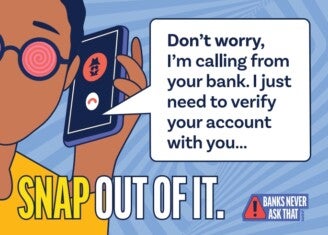Unfortunately, many learn the hard way that fraudsters are good at what they do — especially when it comes to manipulating email content. Sometimes it’s hard to tell if your inbox is full of “real” emails or “fake” ones. Chances are, you’ve gotten some emails you’re just not sure about. Although we can’t tell you for certain which emails are safe, we’ve acquired a few tips you can put into practice to help keep you from falling victim to an email hoax.
Hover over links before clicking on them
Place your mouse over the links in the email without actually clicking them. When you hover over the link, a URL will show up. The preview could populate as a small box beside your cursor or in the bottom of the browser window, as shown in this example. In many cases, if the link includes the root domain of the company’s website then the link is likely legitimate. If you look at the URL and you’re still unsure, do not click on it. To curb any curiosity, you can try manually typing the link in a new window. If it doesn’t go to the site you expected and it’s not secure, now you know the truth.
Check spelling and grammar
Although not everyone who emails you will follow all the rules of grammar, major mistakes are usually a good indication that the sender might be a scammer. Think about it: if a professional individual or organization was contacting you via email, wouldn’t they take care to ensure the message used proper grammar and spelling? Mistakes would hurt their credibility. As mentioned by StaySafeOnline.org, scammers might actually use misspellings and grammar errors on purpose as a way of reeling in less-observant people who would likely fall victim to their efforts.
Pay attention to any unexpected attachments
Any time an email comes with an attachment, opening the file poses a risk. Many email accounts have spam filters that will remove messages that include high-risk attachments, but some still fall through the cracks. Use discretion when you open these messages. Think, have you ever received an attachment from this institution? Did you request a file to be sent to you? If those answers are no, consider the attachment might be a phishing attack. When you receive an email attachment claiming to be from a person or organization you know, the best practice is to contact them directly via phone or another trusted method and ask if the email was really from them.
Be wary of requests for sensitive information
You’ve probably heard this before, but you should always be suspicious when you’re asked for personal information online, especially bank account details, passwords, or your Social Security number.
If you’re a customer with SouthEast Bank, know that although we may contact you by phone, text, or email, we will never initiate communication by asking for your account number, PIN, password, or other personal information.
One common way scammers will try to get your personal information is by saying, “Your account has been compromised. Immediate action required,” or “Your password has expired. Login to change it.” Any message that appeals to a sense of urgency or a fear that something might be wrong with your account is liable to be a scam, so it’s important to learn how to decipher real emails from fake ones.
The online world can be a scary place – that’s a sad but honest truth. Scammers and phishers are always on the watch, waiting for innocent people to slip up. The advice above is intended to be helpful in protecting ourselves from these vicious attacks. Keep these tips in mind, and if you’re still unsure, follow the old adage: it’s better to be safe than sorry.
Information contained in this blog is for educational and informational purposes only. Nothing contained in this blog should be construed as financial, legal or tax advice. An attorney, financial advisor, and/or tax advisor should be consulted for advice based on your circumstances.
Links to other websites or references to services or applications are provided as a convenience only. A link does not imply SouthEast Bank’s sponsorship or approval of any other site, service or application. SouthEast Bank does not control the content of these sites, services or applications.




